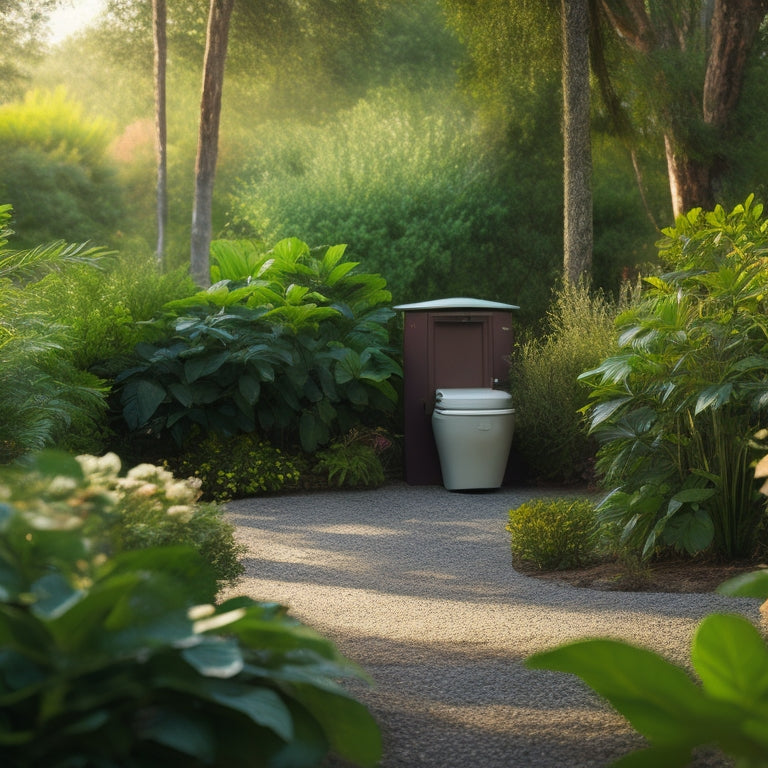
3 Best Odor-Eliminating Hacks for Composting Toilets
Share
You can effectively eliminate odors in your composting toilet by utilizing natural odor absorbers like baking soda and essential oils, maintaining your carbon filter through regular checks and replacements, and emptying and cleaning your collection container frequently. Sprinkling baking soda after use, incorporating solar-powered charging systems, and using biodegradable bags can also enhance odor control. By implementing these hacks, you'll be able to minimize unpleasant smells and guarantee a comfortable and hygienic experience. By understanding these fundamental principles, you'll be well on your way to perfecting odor elimination and revealing a more efficient composting process.
Key Takeaways
- Sprinkling baking soda after each use neutralizes unpleasant smells and enhances odor control in composting toilets.
- Incorporating essential oils like tea tree and lemon oil reduces bacteria and microorganism growth, naturally deodorizing the toilet.
- Regularly checking and replacing carbon filters ensures optimal odor trapping and prevents the buildup of unpleasant smells.
- Maintaining good airflow around the toilet and cleaning the filter housing prevents moisture accumulation and dust buildup.
- Emptying the collection container when 2/3 full and using biodegradable bags makes cleanup efficient and reduces odor-causing bacteria growth.
Natural Odor Absorbers Work
When it comes to eliminating odors in composting toilets, natural odor absorbers are an effective solution. You can count on baking soda, a natural absorber, to neutralize unpleasant smells.
Additionally, incorporating solar-powered charging systems into your composting toilet maintenance can also reduce energy costs and promote sustainability. Simply sprinkle a small amount of baking soda into the toilet after use, and let it work its magic.
For an extra enhancement, add a few drops of essential oils like tea tree oil or lemon oil, which have natural deodorizing properties. These oils can also help reduce the growth of bacteria and other microorganisms that contribute to odors.
Effective Carbon Filter Maintenance
Your carbon filter is the unsung hero of your composting toilet's odor-elimination arsenal, working tirelessly behind the scenes to trap and neutralize particles that would otherwise escape into the air.
To guarantee peak performance, you need to maintain it properly. Understanding the importance of proper waste disposal, such as recycling hazardous waste, can also contribute to a more sustainable and environmentally-friendly composting process.
Proper maintenance of recycling facilities can save up to $5,000 annually, extending equipment lifespan and reducing energy consumption. Here's how:
-
Check and replace your filter regularly: A clogged or exhausted filter can't trap odors effectively, so make certain to replace it according to the manufacturer's schedule or when you notice a decrease in performance.
-
Manage airflow: Maintain good airflow around your composting toilet to prevent moisture buildup, which can compromise your filter's effectiveness.
-
Clean the filter housing: Regularly clean the filter housing to prevent dust and debris from accumulating and reducing airflow.
Regular Emptying and Cleaning
The composting toilet's collection container requires regular emptying and cleaning to prevent the buildup of harmful pathogens and odors.
Implementing renewable energy solutions in your daily operations can also contribute to a cleaner environment.
You'll need to empty the container when it's about 2/3 full, or as recommended by the manufacturer. Use biodegradable bags to line the container, making cleanup easier and more efficient.
When emptying, wear gloves and wash your hands thoroughly afterward. Clean the container with a mild detergent and warm water, then rinse and dry completely.
Regular cleaning will prevent the growth of bacteria and fungi, reducing odors and maintaining a healthy composting environment.
Follow these composting tips to keep your toilet running smoothly and odor-free.
Frequently Asked Questions
Can I Use Composting Toilets in Extremely Cold or Hot Climates?
As you venture into the uncharted territories of extreme climates, you'll find that composting toilets can thrive, but it's essential you adapt with savvy installation tips and climate considerations that'll keep your system firing on all cylinders.
Are Composting Toilets Suitable for People With Mobility or Disability Issues?
You'll find composting toilets can be suitable for people with mobility or disability issues, thanks to innovative accessibility features and user-friendly designs that cater to diverse needs, ensuring independence and freedom in personal hygiene.
Do Composting Toilets Attract Pests or Rodents?
You'll be relieved to know that, with proper pest prevention and odor control, composting toilets won't attract unwanted critters. You're ensuring a pest-free experience by maintaining a balanced carbon-to-nitrogen ratio, adequate aeration, and regular turnings to keep your toilet contents fresh and uninviting to pests.
Can I Compost Toilet Paper and Other Non-Organic Materials?
You're sailing into uncharted waters when composting, so steer carefully: don't add toilet paper, as it's not readily biodegradable; stick to certified compost materials that break down efficiently, ensuring a smooth process that's free from unwanted surprises.
Are Composting Toilets More Expensive Than Traditional Toilets?
You'll find that composting toilets can be more expensive upfront, but consider the long-term cost comparison: they reduce water consumption and sewage costs, while traditional toilets' installation expenses add up over time, making composting toilets a worthwhile investment in your freedom.
Related Posts
-

3 Best Solar-Powered Biodegradable Accessories for Your Home
You're taking a significant step towards a more sustainable lifestyle by incorporating solar-powered biodegradable ac...
-

7 Best Geothermal Cooling Systems for Hot Climate Homes
You're evaluating geothermal cooling systems for your hot climate home, and you want to know the top options. Look fo...
-

10 Powerful Electric Mowers for Expansive Lawns
You're moving away from gas-powered mowers and exploring electric options for your expansive lawn. You'll find that h...


